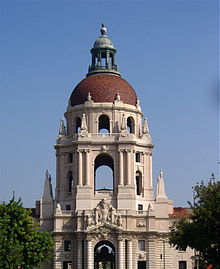Mediterranean Revival architecture: Difference between revisions
m Bot: Migrating 1 interwiki links, now provided by Wikidata on d:Q7937337 |
mNo edit summary |
||
| Line 4: | Line 4: | ||
Peaking in popularity during the 1920s and 1930s, the movement drew heavily on the style of [[palace]]s and seaside [[villa]]s and applied them to the rapidly expanding coastal resorts of [[California]] and [[Florida]]. |
Peaking in popularity during the 1920s and 1930s, the movement drew heavily on the style of [[palace]]s and seaside [[villa]]s and applied them to the rapidly expanding coastal resorts of [[California]] and [[Florida]]. |
||
Structures are typically |
Structures are typically based on a rectangular floor plan, and feature massive, symmetrical primary façades. [[Stucco]]ed walls, red [[tile]]d roofs, windows in the shape of arches or circles, one or two stories, wood or [[wrought iron]] [[Balcony|balconies]] with window grilles, and articulated door surrounds are characteristic.<ref>{{cite book|last=Harris|first=Cyril M.|title=American architecture : an illustrated encyclopedia|year=1998|publisher=Norton|location=New York, NY [u.a.]|isbn=0393730298|page=211}}</ref> [[Keystone (architecture)|Keystone]]s were occasionally employed. Ornamentation may be simple or dramatic. Lush gardens often appear. |
||
The style was most commonly applied to hotels, apartment buildings, commercial structures, and residences. Architects [[August Geiger (architect)|August Geiger]] and [[Addison Mizner]] were foremost in Florida, while [[Bertram Goodhue]], Sumner Spaulding, and [[Paul Williams (architect)|Paul Williams]] were in California. |
The style was most commonly applied to hotels, apartment buildings, commercial structures, and residences. Architects [[August Geiger (architect)|August Geiger]] and [[Addison Mizner]] were foremost in Florida, while [[Bertram Goodhue]], Sumner Spaulding, and [[Paul Williams (architect)|Paul Williams]] were in California. |
||
Revision as of 13:34, 22 March 2013

Mediterranean Revival is a design style introduced in the United States in the waning nineteenth century variously incorporating references from Spanish Renaissance, Spanish Colonial, and Beaux-Arts and Italian Renaissance architecture.
Peaking in popularity during the 1920s and 1930s, the movement drew heavily on the style of palaces and seaside villas and applied them to the rapidly expanding coastal resorts of California and Florida.
Structures are typically based on a rectangular floor plan, and feature massive, symmetrical primary façades. Stuccoed walls, red tiled roofs, windows in the shape of arches or circles, one or two stories, wood or wrought iron balconies with window grilles, and articulated door surrounds are characteristic.[1] Keystones were occasionally employed. Ornamentation may be simple or dramatic. Lush gardens often appear.
The style was most commonly applied to hotels, apartment buildings, commercial structures, and residences. Architects August Geiger and Addison Mizner were foremost in Florida, while Bertram Goodhue, Sumner Spaulding, and Paul Williams were in California.
List of example structures

- Hayes Mansion in San Jose, California, completed in 1905
- Villa Vizcaya in Miami, Florida, completed in 1914
- Presidio building in San Francisco, California, completed in 1912
- The Ambassador Hotel in Los Angeles, California, 1921 (demolished)
- Temple Terrace Country Club in Temple Terrace, Florida, completed in 1921
- (Former) Southern Pacific Railroad Depot in Glendale, California, completed in 1923
- Freedom Tower in Miami, Florida, completed in 1925
- Vinoy Park Hotel in St. Petersburg, Florida, completed in 1925
- Snell Arcade in St. Petersburg, Florida. 1925
- Boca Raton Resort & Club in Boca Raton, Florida, completed in 1926
- Miami-Biltmore Hotel in Coral Gables, Florida, completed in 1926
- Fort Harrison Hotel in Clearwater, Florida, completed in 1926
- Cà d'Zan, former John Ringling estate in Sarasota, Florida, completed in 1926
- Francis Marion Stokes Fourplex in Portland, Oregon, completed in 1926
- Pasadena City Hall in Pasadena, California, 1927
- Winter Park Ninth Grade Center 1927
- Greenacres (Former Harold Lloyd Estate) in Beverly Hills, California, completed in 1928
- Don CeSar Hotel, St. Pete Beach, Florida, completed in 1928
- Beverly Shores Railroad Station, 1928
- Mildred Building, Beaumont, Texas 1929
- Port Washington Fire Engine House in Port Washington, Wisconsin, completed in 1929
- Casa Casuarina (Versace Mansion, now known as The Villa By Barton G.) in Miami Beach, Florida, 1930
- Santa Fe Railway (now Amtrak and Metrolink) depot in Fullerton, California, completed 1930
- Beverly Hills City Hall, Beverly Hills, California, 1932
- Cabrillo Beach Bath House in San Pedro, California, completed 1932
- Francis Lederer residence, in West Hills, Los Angeles, California, completed 1936[2]
- Cooley High School, Detroit, Michigan, built in 1928
- W.J. Bryan Elementary School , in Miami,Florida,completed in 1928
See also
- Gothicmed-project which includes finding further insight to Gothic architecture in the Mediterranean area
- Mission Revival Style architecture
- Spanish Colonial style architecture
- Spanish Colonial Revival Style architecture
- Moorish Revival architecture
References
- ^ Harris, Cyril M. (1998). American architecture : an illustrated encyclopedia. New York, NY [u.a.]: Norton. p. 211. ISBN 0393730298.
- ^ Big Orange-Lederer Residence
- Gustafson, Lee and Phil Serpico (1999). Santa Fe Coast Lines Depots: Los Angeles Division. Acanthus Press, Palmdale, CA. ISBN 0-88418-003-4.
- Newcomb, Rexford (1992). Mediterranean Domestic Architecture for the United States. Hawthorne Printing Company, New York, NY. ISBN 0-926494-13-9.
- Signor, John R. (1997). Southern Pacific Lines: Pacific Lines Stations, Volume 1. Southern Pacific Historical and Technical Society, Pasadena, CA. ISBN 0-9657208-4-5.
- Nolan, David. The Houses of St. Augustine. Sarasota, Pineapple Press, 1995.
- Nylander, Justin A. (2010). Casas to Castles: Florida's Historic Mediterranean Revival Architecture. Schiffer publishing. ISBN 978-0-7643-3435-1.
